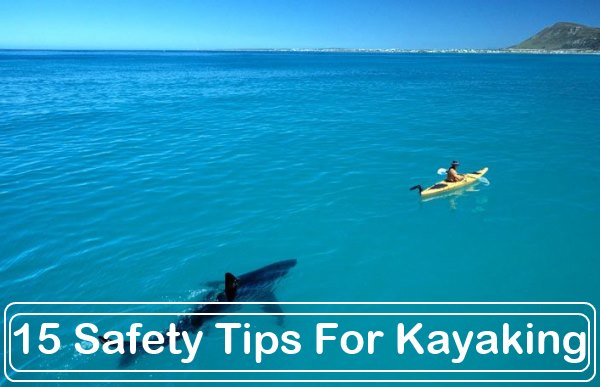The question of safety accompanies almost everyone who goes kayaking for the first time. Your friends will be happy to regale you with stories of various unpredictable situations that happened to them, and on the internet, you will find many chilling stories.
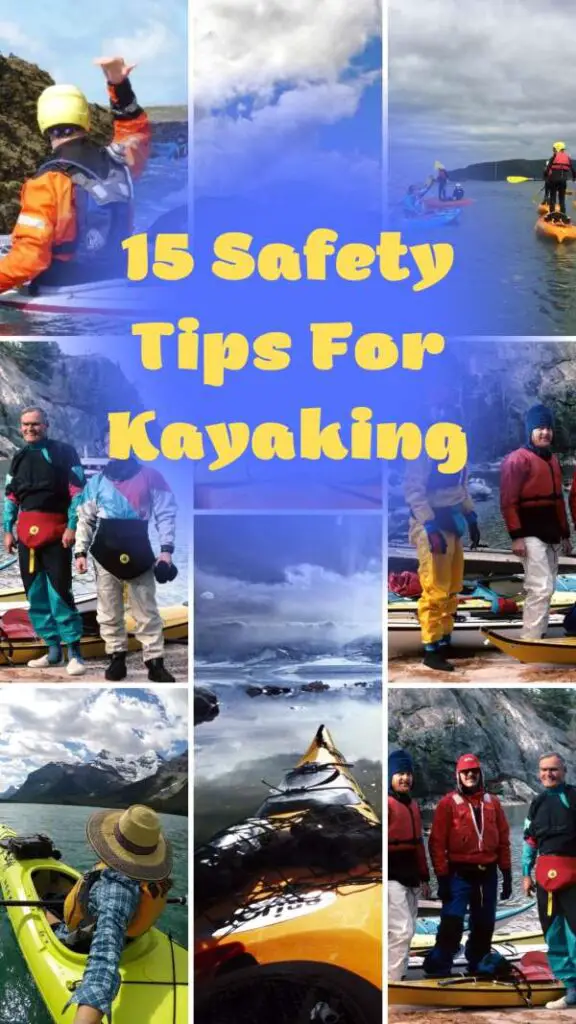
Hence, the decision to go kayaking for the first time in your life may not be easy and may be associated with many doubts. However, if you want to increase your feeling of safety, follow some simple rules. We will present them in the following text.
Table of Contents
1 – Check the route before rafting
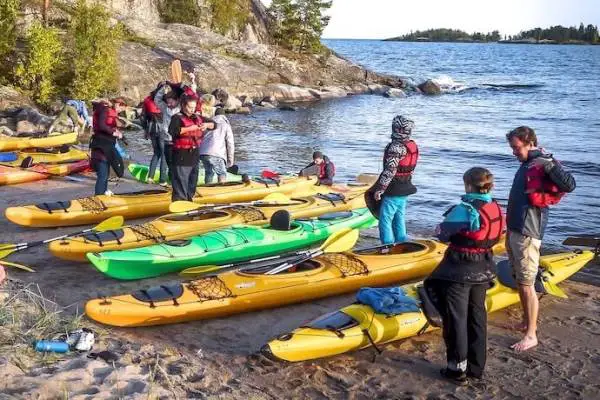
You can use the Google Maps satellite view to check the rafting route. See how the riverbed is shaped and how the glades are located. The satellite map also shows ports (places where you’ll have to go ashore and haul your kayaks). The more you know about a particular river, the better. Make sure the route – and especially the number of crossings – matches your capabilities. On our website under Kayaking, you can find descriptions with kayak rental locations of the best routes in each state of the USA that we have researched, the routes can be for kids or for professionals.
2 – Adapt to the weather conditions
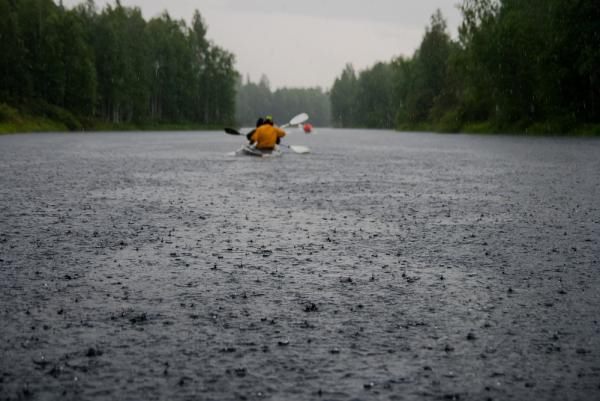
When going rafting, always check the weather conditions of the day and adjust your clothing accordingly. It’s best to wear comfortable, non-restrictive clothing and be prepared for any circumstance. You will need special sports shoes for water (they can’t be wellingtons – they will pull you to the bottom in case of capsizing), a thin fleece, a jacket or a raincoat, and a set of spare clothes (here is more information about what to take for kayaking). If the weather is forecast to change choose a shorter route, to reach the base safely. When weather conditions are very bad (strong wind, threat of thunderstorm) or the current of the river is strongly swollen, resign from going on the water at all.
3 – Take a first aid kit

An emergency first aid kit will come in handy on any rafting trip. It should be packed tightly, so it won’t get wet. It’s also a good idea to have someone among your participants who knows how to give first aid – and it’s even better to learn how to do it yourself.
4 – Learn about equipment and paddling techniques
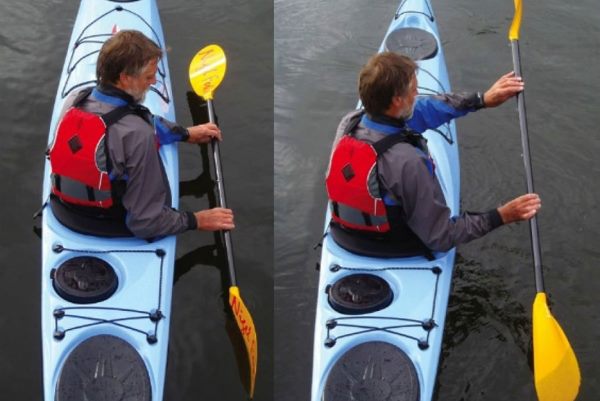
Before setting off, try to find out more about the kayak, which you will sail – its parameters, capabilities, and weaknesses. Ask the rental staff about potentially difficult situations and how to deal with them. Ask also for instructions on getting in and out of the kayak, paddling techniques, and ways to avoid obstacles on the route. You can learn more about steering a kayak on our post First kayaking trip. Kayak steering and safe boarding.
5 – Choose your kayak paddlers appropriately
If possible, a single pair of kayakers should consist of a more experienced person and a beginner. This rule is difficult to fulfill if all participants of a canoeing trip are taking part in it for the first time. However, most often there are several people in the group who have had contact with water sports. These people will learn to paddle faster, so it’s a good idea to pair them with novices. As for the distribution of people in the kayak, at the back sits a more experienced person, heavier and stronger, and at the front – a beginner, lighter and having less strength.
Personal composition of particular crews should be established already at the stage of planning a canoeing rally, especially if canoeing rally children are to take part (here more on the subject of children in the kayaking rally), and the route itself should be chosen according to participants’ abilities and skills. It’s worth remembering that a group of people should always go canoeing. You shouldn’t go alone – in case of a capsize or other unforeseen circumstances, it’s harder to get help.
6 – Appoint a leader, determine the order of settlements
In a group of rafters, you need a rafting leader. In critical situations, he will make decisions, and the group will have to obey him. He should be the most experienced kayaker, and ideally, he should also know the route of the trip.
During the canoeing trip, the leader is always the first (other groups are not allowed to overtake him). The leader is followed by the least experienced participants and the more experienced ones who close the line. It is also necessary to decide which of the teams will always be the last. Other participants of the canoeing race must make sure not to lag behind. The last group should also have a first aid kit with them, which allows them to provide help efficiently in case of need. The distance between the settlements must be such that you have at least one settlement in sight in front of you and one behind you; the settlements must also not be stretched too far along the canoeing route so that they can find each other easily. The rafting leader and people from the last settlement should also be in phone contact with each other.
7 – Wear your safety vest
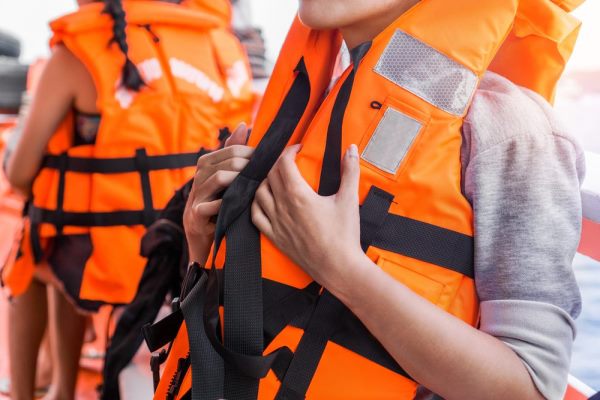
Before setting off, you and every other participant on the canoeing trip will receive a safety vest from the company renting the canoe. During kayaking trips, you have to wear a vest all the time. Even though it may hinder movement or not match other clothing, it can save the life of someone who cannot swim. It can also help an excellent swimmer to carry help to another person or an experienced kayaker who suddenly faints and falls into the water. Vests are mandatory for children and people who feel insecure because they do not know the river or cannot swim well. During cold weather or wind, a vest can also provide an extra layer of insulation.
8 – Protect your equipment
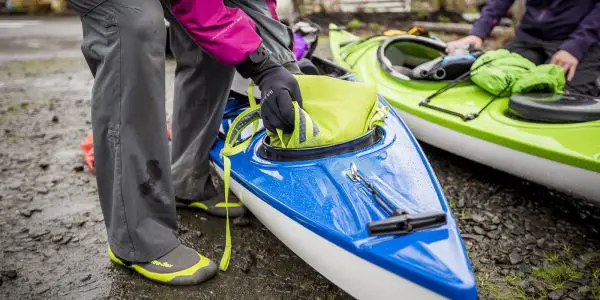
It’s better to be prepared for a bad scenario and then be pleasantly surprised if your stuff gets wet when there’s a rollover or it starts to rain. So pack your luggage properly. Put your electronics or cameras in a special waterproof case (you can buy one at any sports store). Larger items such as clothes or shoes should be packed in trash bags. For greater safety, we recommend the use of rubber bags or 30-liter bags specifically designed for water sports. In the event of a possible rollover, such a bag will float on the water, protecting your belongings not only from getting wet but also from drowning.
9 – Always swim during the day

Start rafting at such a time as to finish at least an hour before dusk. In the dark, you will not notice any obstacles on the river – stones, tree branches, dams, and water rapids. In the dark, it is also more difficult to provide effective first aid in case you, someone from your group, or someone else gets into trouble.
10 – Remember the basic rules of movement
When you’re paddling across the lake, stay close to the shore and put more effort into paddling so that the wind and current don’t push you into the middle of the lake. If there are larger waves on the lake or a motorboat passes you by, the safest thing to do is to position the kayak with the bow “on the wave” (that is, perpendicular to the wave).
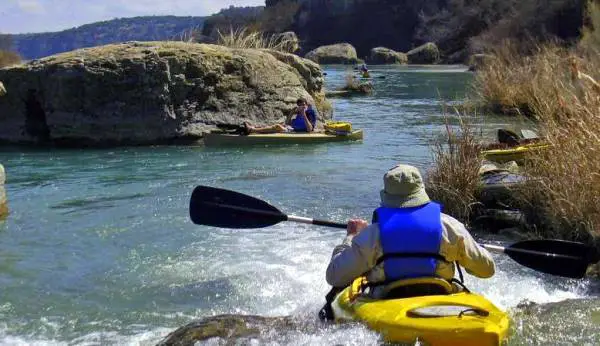
When you are paddling on a river, watch the water surface in front of your kayak. Waves and eddies indicate underwater obstacles that must be avoided.
When overcoming obstacles, bends, and footbridges, you can help yourself with a paddle or hands, pushing off from trees, branches, or river banks. Swim under footbridges at the point where the distance between the water surface and the bottom of the footbridge is the greatest. If the footbridge (or another obstacle above the water) is low, lie down in the kayak, paddle along with it, and help yourself with your hands. In places where the river bottom is rocky, you need to swim where it is deepest so as not to damage your kayak.
When approaching obstacles in the case of inexperienced crews, it is best to apply the rule that only the person sitting at the back paddles and steers. Be especially careful when approaching transverse obstacles – for example, tree trunks lying across the river current. Do not let the current push you against such an obstacle. If this happens, do not lean away from the obstacle so that the river current does not overturn you – you should always lean towards the obstacle.
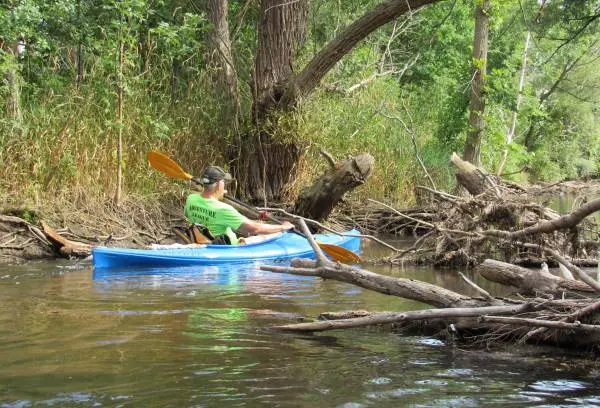
Do not kayak through dangerous places – such as half-submerged logs, visible eddies, water steps, thresholds, locks, and weirs. To avoid them, get ashore and carry your kayak by land to the other side of the obstacle. If the water level is low, stick to the current of the river in order not to settle on the shoals. If you stop on the shoal, check with a paddle the degree of siltation of the bottom and only then get out of the kayak.
11 – Keep distance between the kayaks
On canoeing trips, you should keep a proper distance from other canoes. It is about 10-15 meters. This will allow you to overcome obstacles, such as fallen trees. The river flows at a certain speed, pushing the canoe, and in places where the current narrows, it can easily collide with other kayakers and as a result – capsize. That is why you should keep a safe distance from other kayakers and carefully watch the current of the river in front of you. At the same time, you need to keep visual contact with the crew in front of you and the crew behind.
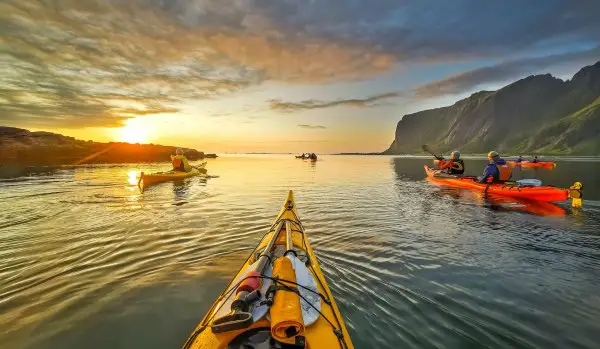
If there is a blockage on the river, swim to the shore, stop, and wait for the crew of the canoe that caused the blockage to overcome the problem. You can also back out by paddling backward. If you paddle forward and try to avoid the blockage, you will be hindering rather than helping. It is also worth agreeing in advance with all participants of the canoeing on the command given in the case of a blockage by the leader and passed on – for example, “stop on the water”).
In case of capsizing the kayak, you should act similarly. The crew closest to the injured gives the command to stop, the most efficient crews provide assistance to the injured, and all other crews swim to the river bank and wait there for the development of events.
12 – Behave carefully in a kayak
Once you are in the kayak, behave carefully and sensibly. Be careful when getting in and out of the kayak, because during these activities most capsizes happen. When you get in or out of the kayak, set the bow against the current of the river. Such an arrangement will also help you reach the shore more easily.
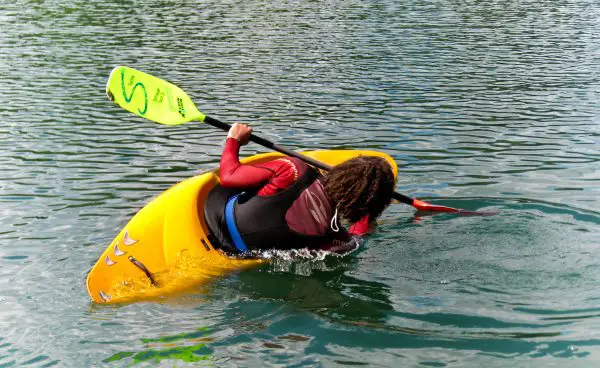
When you are in the kayak, sit in the cockpit, and do not squat or stand on straight legs. Do not jump from the kayak into the water. Do not sit on the side of the kayak, do not swing from side to side, or push off other kayaks with your paddles. You can damage the equipment or expose yourself to capsize. When kayaking, do not try to stop the canoe by catching branches of trees or bushes growing on the shore – this is also a common cause of capsizes.
13 – Remember about other people on the water
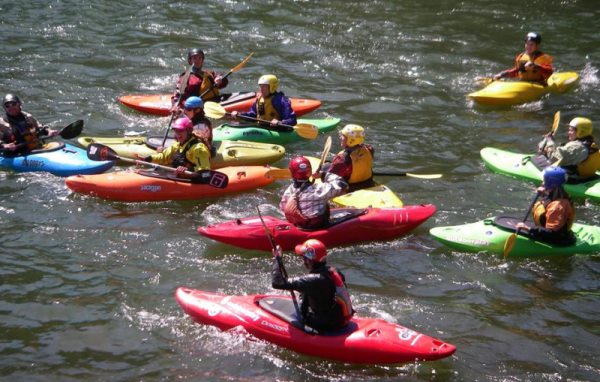
Pay attention to other people using the river – participants of your rafting trip, other rafters, as well as people swimming or fishing. Always help people who are in trouble. Various unpredictable situations can happen on the water, so you should be able to count on each other.
14 – The larger craft always has priority
A kayak is a small boat. It has greater maneuverability than other vessels, so the driver is required to give way to boats or motorboats. Always keep a good distance from the largest watercraft (ships, barges, ferries).
15 – Alcohol only after rafting

Emphasis: “alcohol only after rafting, around the campfire“. Never get in a kayak after drinking alcohol or using other drugs. They will cause an extension of your reaction time, meanwhile, during kayaking, you have to react or decide immediately. Drugs may also cause, that you will start to ignore the obstacles or will start bravado leading to risky behavior. Drinking alcohol also accelerates the loss of heat from the body and severely dehydrates it, especially in the sun. We discuss this topic in more detail in the entry about alcohol in kayaking. And instead of stronger drinks, it is worth taking an adequate supply of water.
We hope that our entry has familiarized you with all aspects of safe participation in kayaking. The more aware you are of all the risks and the more attentive you are to what is going on around you, the greater the chance that the canoeing trip itself will go without any major problems and you will take home only good memories.
Recommended reading – Can you get a DUI on a kayak?
FAQ
How can you be safe on a kayak?
Ensuring safety while kayaking is crucial for an enjoyable and risk-free experience. Here are some key safety measures to follow when kayaking:
Wear a Personal Flotation Device (PFD): Always wear a properly fitting PFD while kayaking. It provides buoyancy and can save your life in case of an emergency.
Check Weather and Water Conditions: Before heading out, check the weather forecast and current water conditions. Avoid kayaking in adverse weather, strong winds, or challenging conditions beyond your skill level.
Know Your Limits: Paddle within your skill level. Avoid attempting advanced conditions or routes until you have gained the necessary experience.
Use the Right Equipment: Use a kayak suitable for your skill level and intended activity. Ensure it’s in good condition, and carry essential safety equipment, such as a paddle leash and signaling devices.
Inform Others: Let someone on shore know about your kayaking plans, including your intended route and expected return time. This is a safety precaution in case of emergencies.
Paddle with a Buddy: Whenever possible, paddle with a partner. Having someone else on the water with you provides assistance and support.
Stay Close to Shore: Stick to paddling close to the shoreline on your initial outings. Avoid venturing too far from safety points.
Learn Self-Rescue Techniques: Learn and practice self-rescue techniques, such as how to re-enter your kayak after a capsize. These skills can boost your confidence and safety.
Respect the Environment: Follow Leave No Trace principles and respect the environment. Minimize your impact by not disturbing wildlife and disposing of trash properly.
Use Navigation Aids: If you’re paddling in unfamiliar waters, use navigation aids like maps, compasses, or GPS devices to stay oriented.
Stay Hydrated and Protected: Bring water and sun protection (sunscreen, hat, sunglasses) to stay hydrated and protect yourself from the sun’s harmful effects.
Follow Local Regulations: Be aware of and adhere to local kayaking regulations, such as no-wake zones, restricted areas, and specific safety requirements.
Be Prepared for Emergencies: Carry a basic first aid kit and know how to use it. Also, consider having a spare paddle and tools for basic repairs.
Practice Situational Awareness: Be aware of your surroundings and the movements of other boaters. Avoid collisions and maintain a safe distance from other watercraft.
By following these safety guidelines, you can minimize risks and ensure a safe and enjoyable kayaking experience. Remember that safety is paramount, and being well-prepared will contribute to your peace of mind on the water.
What are four mistakes in kayaking?
Four common mistakes in kayaking that can lead to safety issues and less enjoyable experiences are:
Inadequate Safety Precautions: Neglecting safety measures is a significant mistake. This includes not wearing a personal flotation device (PFD), not carrying essential safety gear, or not having a proper float plan. Failing to prioritize safety can lead to dangerous situations.
Overestimating Skills: Some kayakers make the mistake of attempting advanced conditions or challenging routes without the necessary skills and experience. Overestimating your abilities can lead to accidents, capsizes, or getting stranded.
Ignoring Environmental Impact: Disregarding environmental ethics is another mistake. This includes littering, disturbing wildlife, or not following Leave No Trace principles. Such behavior harms the environment and can lead to legal consequences. It’s essential to respect nature and minimize your impact.
Lack of Proper Gear and Clothing: Not having adequate clothing or equipment is a mistake that can lead to discomfort and even hypothermia in cold conditions. Always dress appropriately and carry essential gear, including a PFD, paddle leash, and dry bags for your belongings.
Avoiding these mistakes and continuously improving your kayaking knowledge and skills will contribute to a safer and more enjoyable kayaking experience.
What to avoid when kayaking?
To ensure a safe and enjoyable kayaking experience, here are several things to avoid while kayaking:
Overloading the Kayak: Do not exceed the weight limit of your kayak or load it unevenly. Overloading can affect stability and safety.
Neglecting Safety Gear: Do not paddle without essential safety gear, including a properly fitting personal flotation device (PFD), a whistle, and signaling devices.
Ignoring Weather Conditions: Do not disregard weather forecasts. Always check weather conditions and be prepared for changes on the water.
Underestimating Water Conditions: Do not paddle in water conditions beyond your skill level. Strong currents, high winds, and challenging waves can be dangerous if you’re not prepared.
Disregarding Your Skill Level: Do not attempt kayaking in advanced conditions if you lack the necessary skills and experience. Start with suitable environments for your ability.
Neglecting Sun Protection: Do not forget to protect yourself from the sun. Wear sunscreen, a hat, and sunglasses to prevent sunburn and glare.
Losing Track of Your Position: Do not lose track of your position. Always know your location and plan your route, including recognizing landmarks and navigation points.
Paddling Alone in Remote Areas: Do not paddle alone in remote or unfamiliar areas. It’s safer to have a paddling partner in case of emergencies.
Littering or Polluting: Do not litter in the water. Respect the environment by disposing of trash properly and following Leave No Trace principles.
Disturbing Wildlife: Do not disturb wildlife. Maintain a respectful distance from animals to avoid causing stress or harm to them.
Neglecting Hydration: Do not forget to bring water and stay hydrated during your trip.
Skipping Safety Training: Do not neglect safety training. Learn and practice self-rescue techniques, as well as how to respond to emergencies.
Venturing Without a Plan: Do not paddle without a float plan. Always inform someone about your trip, route, and expected return time.
Panic in a Capsize: Do not panic if you capsize. Stay calm, follow safety procedures, and remember how to re-enter your kayak.
Ignoring Local Regulations: Do not ignore local kayaking regulations or guidelines, such as no-wake zones, restricted areas, or specific safety requirements.
By adhering to these guidelines and avoiding these actions while kayaking, you can enhance your safety, protect the environment, and make the most of your kayaking experiences. Remember to prioritize safety, respect nature, and enjoy the adventure responsibly.
Is kayaking safe for beginners?
Yes, kayaking can be safe for beginners when proper precautions are taken. Kayaking is an accessible and enjoyable outdoor activity that can be enjoyed by people of all skill levels, including those who are new to the sport. To ensure a safe experience for beginners, consider the following tips:
Take a Lesson: If you’re new to kayaking, consider taking a kayaking lesson from a certified instructor. Lessons provide essential guidance on paddling techniques, safety procedures, and rescue skills.
Choose the Right Kayak: Opt for a stable and beginner-friendly kayak. Sit-on-top kayaks are often recommended for novice paddlers because they are more stable and easy to re-enter if you capsize.
Wear a PFD: Always wear a properly fitting personal flotation device (PFD) while kayaking. A PFD provides buoyancy and is a critical safety feature.
Start in Calm Waters: Begin your kayaking journey in calm and sheltered waters, such as a calm lake or slow-moving river. These conditions are more forgiving for beginners.
Inform Others: Let someone on shore know about your kayaking plans, including your intended route and expected return time. This is a safety precaution in case of emergencies.
Stay Close to Shore: Stay near the shoreline on your initial outings and avoid venturing too far from safety points.
Practice Self-Rescue: Learn and practice self-rescue techniques, such as how to re-enter your kayak after a capsize. These skills can boost your confidence and safety.
Check Weather Conditions: Before heading out, check weather conditions and forecasts. Avoid kayaking in adverse weather, especially strong winds and storms.
Stay Hydrated: Bring water and stay hydrated during your trip.
Paddle with a Buddy: Paddling with a partner is safer, especially for beginners. Having someone else with you provides assistance and support in case of emergencies.
While kayaking is generally safe for beginners, it’s essential to prioritize safety, seek knowledge, and use appropriate equipment. As you gain experience and confidence, you can gradually explore more challenging environments and longer distances. Always follow safety guidelines and be prepared for any changes in weather or water conditions.
Is it safe to kayak with no experience?
Kayaking without any experience can be safe if you follow certain guidelines and take appropriate precautions. Here are some key considerations for kayaking with no experience:
Take a Lesson: Consider taking a kayaking lesson from a certified instructor. Lessons provide valuable guidance on paddling techniques, safety procedures, and rescue skills.
Start in Calm Waters: Begin your kayaking journey in calm and sheltered waters, such as a calm lake or slow-moving river. These conditions are more forgiving for beginners.
Use a Stable Kayak: Choose a stable and beginner-friendly kayak. Sit-on-top kayaks are often recommended for novice paddlers because they are more stable and easier to re-enter in case of a capsize.
Wear a PFD: Always wear a properly fitting personal flotation device (PFD) while kayaking. It provides buoyancy and safety.
Inform Others: Let someone on shore know about your kayaking plans, including your intended route and expected return time. This is a safety precaution in case of emergencies.
Stay Close to Shore: Stay near the shoreline and avoid venturing too far from safety points on your initial outings.
Practice Self-Rescue: Learn and practice self-rescue techniques, such as how to re-enter your kayak after a capsize. These skills can boost your confidence and safety.
Check Weather Conditions: Before heading out, check weather conditions and forecasts. Avoid kayaking in adverse weather, especially strong winds and storms.
Stay Hydrated: Bring water and stay hydrated during your trip.
Paddle with a Buddy: It’s safer to kayak with a partner, especially as a beginner. Paddling with someone else provides assistance and support.
While it’s possible to kayak safely with no experience, taking lessons and starting in easy conditions will help you learn the fundamentals and build your skills gradually. As you gain experience and confidence, you can explore more challenging environments and longer distances. Safety, knowledge, and proper equipment are key to a positive kayaking experience, especially for beginners.
How do you use bathroom when kayaking?
When kayaking, there may come a time when you need to use the bathroom. Here are some guidelines for managing this situation:
Plan Ahead: Before your kayaking trip, familiarize yourself with the available facilities along your route. Know where public restrooms, campgrounds, or designated toilet areas are located.
Leave No Trace: If you’re in a remote area without restrooms, follow Leave No Trace principles to minimize your environmental impact. Choose a location at least 200 feet (70 steps) away from water sources, campsites, and trails.
Use a Portable Toilet: Portable camping toilets are available for outdoor use. These can be a convenient and sanitary option. Ensure you pack out and dispose of waste properly.
Use a Biodegradable Bag: Biodegradable toilet bags, sometimes called “wag bags,” are designed for waste disposal in outdoor settings. They break down over time, and you can use them in combination with a portable toilet or in a shallow hole.
Follow Local Regulations: Be aware of any specific regulations or guidelines related to waste disposal in the area you’re kayaking. Some locations may have specific rules for human waste.
Carry Toilet Paper and Sanitizer: Pack toilet paper and hand sanitizer in a waterproof container. These can be useful for hygiene during and after bathroom breaks.
Practice Discretion: If you need to go while on the water, find a secluded spot to maintain privacy and minimize the risk of encountering other kayakers.
Secure Waste: Ensure that waste is properly sealed and carried out in a designated container or bag. Dispose of it in accordance with local regulations.
Consider Peeing in the Water: For urination, some kayakers choose to relieve themselves in the water, away from others. However, this is not a recommended practice in areas where it may impact water quality or regulations prohibit it.
Always prioritize environmental responsibility and follow established guidelines for waste disposal. Proper planning and adherence to outdoor ethics ensure a positive kayaking experience while minimizing your impact on the environment.
How do you carry your phone while kayaking?
Carrying your phone safely while kayaking is important to stay connected, take photos, or use navigation apps. Here are some common ways to carry your phone while kayaking:
Waterproof Phone Case: Invest in a waterproof phone case or pouch designed for outdoor activities. These cases are designed to keep your phone dry even if it gets wet. Ensure it’s securely sealed before placing it in the case.
Dry Bag: Use a dry bag or dry pouch to store your phone and other valuables. Dry bags are available in various sizes and are designed to keep contents dry, even when submerged.
Deck Bag: Consider attaching a deck bag to the front of your kayak. These bags have transparent pockets where you can place your phone for easy access. Some deck bags are designed to be waterproof or come with waterproof covers.
PFD Pocket: Some personal flotation devices (PFDs) have pockets designed to hold small items, including phones. Ensure the pocket is waterproof or use a waterproof case or pouch within the pocket.
Leash: Attach a leash or tether to your phone case or pouch and secure it to your kayak or PFD. This prevents accidental loss if you drop your phone.
Ziplock Bag: In a pinch, you can use a resealable plastic bag (like a Ziplock bag) to protect your phone. Make sure it’s sealed tightly and consider double-bagging for added protection.
Wrist or Neck Lanyard: Use a waterproof phone case with an attached wrist or neck lanyard to keep your phone accessible and secure.
Waist Belt: Some waterproof pouches have a built-in waist belt, allowing you to wear it around your waist for easy access while paddling.
Always test the waterproofing of your chosen method before heading out on the water. It’s important to safeguard your phone from water, as exposure to moisture can damage the device. Additionally, consider putting your phone on airplane mode or turning it off to save battery life while kayaking.
Why do you need wet shoes for kayaking?
Wet shoes or water shoes are often recommended for kayaking for several reasons:
Foot Protection: Wet shoes provide protection for your feet against sharp rocks, shells, and other potential hazards in the water. These shoes have sturdy soles that guard your feet from injury.
Grip and Traction: Wet shoes typically have rubber soles with good grip and traction. This helps you maintain stability when getting in and out of your kayak, especially on slippery surfaces.
Comfort: Wet shoes are designed to be comfortable when wet. They drain water quickly and dry relatively fast, keeping your feet comfortable and reducing the risk of blisters or chafing.
Warmth: In cooler water or weather conditions, wet shoes can help keep your feet warm by providing some insulation.
Secure Fit: Wet shoes often have secure lacing or fastening systems, which ensure they stay firmly on your feet even during active kayaking.
Hygiene: Using wet shoes can help protect your feet from coming into direct contact with potentially unclean or sharp surfaces in the water, which can prevent infections or cuts.
Versatility: Wet shoes are not just for kayaking; they are versatile and can be used for various water-based activities like paddleboarding, snorkeling, and beachcombing.
When choosing wet shoes for kayaking, opt for a pair that fits well, has good traction, and provides the level of protection and support you need for your specific kayaking conditions. Wet shoes can enhance your comfort and safety during your kayaking adventures, whether you’re paddling in rivers, lakes, or coastal areas.
Can you put a kayak in the water anywhere?
While kayaking offers great opportunities to explore waterways, it’s essential to be aware that you can’t put a kayak in the water just anywhere. Here are some key considerations:
Public Access: Look for public access points, such as boat ramps, docks, or designated kayak launch areas, where you are allowed to enter the water. These are often found in parks, recreational areas, and waterfront locations.
Private Property: Respect private property rights and avoid entering the water from someone’s private land without permission. Trespassing can lead to legal issues.
Environmental Protection: Be aware of regulations and guidelines designed to protect the environment. Some areas, such as wildlife sanctuaries, wetlands, and sensitive ecosystems, may restrict or prohibit kayaking to safeguard the environment.
Local Regulations: Research and follow local regulations that pertain to kayaking in your area. These may include rules related to safety, no-wake zones, watercraft registrations, and permit requirements.
Safety and Accessibility: Choose access points that are safe and appropriate for your skill level and the type of watercraft you’re using. Some locations may be more suitable for advanced kayakers.
Parking and Facilities: Check if there are parking facilities, restrooms, and other amenities available at the chosen access point.
Landowner Permissions: If you want to kayak in an area without designated access points, seek permission from landowners or local authorities to ensure you have the right to enter the water.
Navigational Concerns: Be aware of navigation channels, shipping lanes, and areas with heavy boat traffic. Kayaking in these areas can be hazardous, so choose your launch location with safety in mind.
It’s important to do your research and plan your kayaking trips accordingly. Local regulations, safety considerations, and environmental protection efforts can impact where and how you can put a kayak in the water. Always respect the rules and the environment while enjoying your kayaking adventures.
Our best posts:

